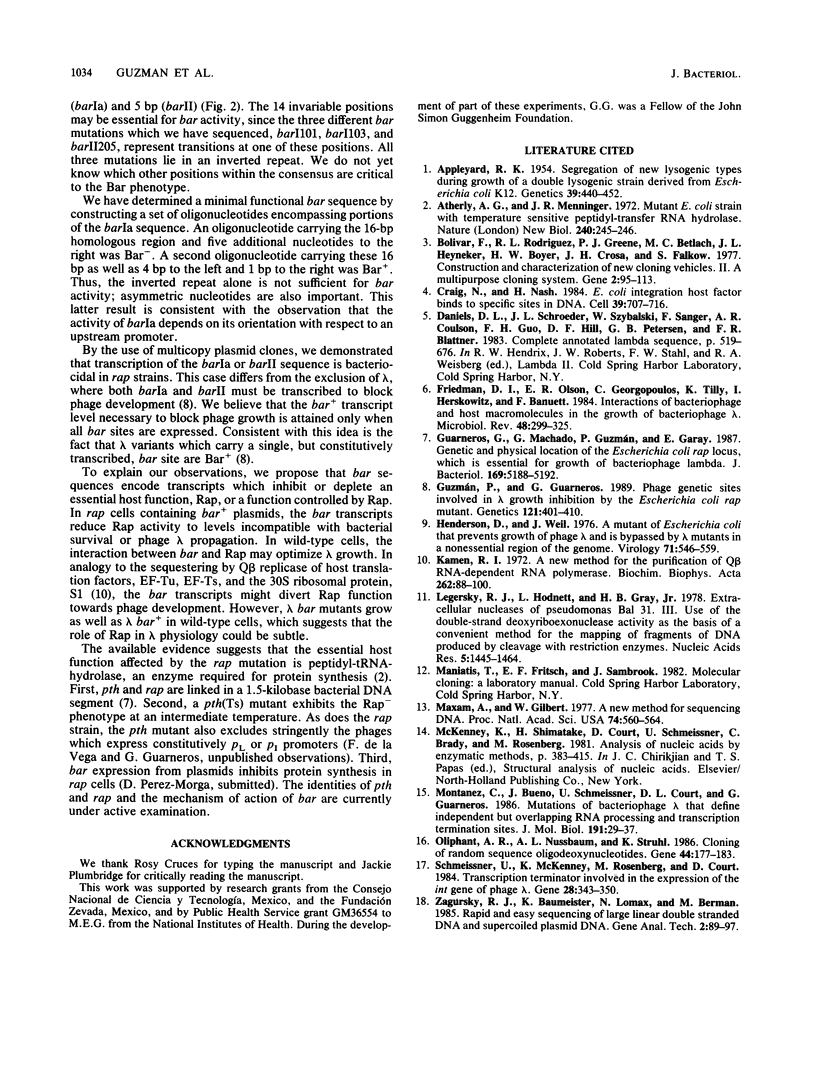Abstract
The rap mutation in Escherichia coli prevents the growth of bacteriophage lambda. Phage mutations that overcome rap inhibition (bar) have been mapped to loci in the pL operon. We cloned and sequenced three mutations in two of these loci: barIa to the left arm of the lambda attachment site (attP) and barII in the ssb (ea10) gene. The mutations represent single base-pair changes within nearly identical 16-base-pair DNA segments. Each mutation disrupts a sequence of dyad symmetry within the segment. Plasmids carrying a bar+ sequence downstream to an active promoter are lethal to rap, but not rap+, bacteria. The bar sequences isolated from the lambda bar mutants are not lethal. We synthesized a minimal lambda barIa+ sequence, 5'-TATATTGATATTTATATCATT, and cloned it downstream to an inducible promoter. When transcribed, this sequence is sufficient to kill a rap strain.
Full text
PDF




Selected References
These references are in PubMed. This may not be the complete list of references from this article.
- Appleyard R K. Segregation of New Lysogenic Types during Growth of a Doubly Lysogenic Strain Derived from Escherichia Coli K12. Genetics. 1954 Jul;39(4):440–452. doi: 10.1093/genetics/39.4.440. [DOI] [PMC free article] [PubMed] [Google Scholar]
- Atherly A. G., Menninger J. R. Mutant E. coli strain with temperature sensitive peptidyl-transfer RNA hydrolase. Nat New Biol. 1972 Dec 20;240(103):245–246. doi: 10.1038/newbio240245a0. [DOI] [PubMed] [Google Scholar]
- Bolivar F., Rodriguez R. L., Greene P. J., Betlach M. C., Heyneker H. L., Boyer H. W., Crosa J. H., Falkow S. Construction and characterization of new cloning vehicles. II. A multipurpose cloning system. Gene. 1977;2(2):95–113. [PubMed] [Google Scholar]
- Craig N. L., Nash H. A. E. coli integration host factor binds to specific sites in DNA. Cell. 1984 Dec;39(3 Pt 2):707–716. doi: 10.1016/0092-8674(84)90478-1. [DOI] [PubMed] [Google Scholar]
- Friedman D. I., Olson E. R., Georgopoulos C., Tilly K., Herskowitz I., Banuett F. Interactions of bacteriophage and host macromolecules in the growth of bacteriophage lambda. Microbiol Rev. 1984 Dec;48(4):299–325. doi: 10.1128/mr.48.4.299-325.1984. [DOI] [PMC free article] [PubMed] [Google Scholar]
- Guarneros G., Machado G., Guzmán P., Garay E. Genetic and physical location of the Escherichia coli rap locus, which is essential for growth of bacteriophage lambda. J Bacteriol. 1987 Nov;169(11):5188–5192. doi: 10.1128/jb.169.11.5188-5192.1987. [DOI] [PMC free article] [PubMed] [Google Scholar]
- Guzmán P., Guarneros G. Phage genetic sites involved in lambda growth inhibition by the Escherichia coli rap mutant. Genetics. 1989 Mar;121(3):401–409. doi: 10.1093/genetics/121.3.401. [DOI] [PMC free article] [PubMed] [Google Scholar]
- Henderson D., Weil J. A mutant of Escherichia coli that prevents growth of phage lambda and is bypassed by lambda mutants in a nonessential region of the genome. Virology. 1976 Jun;71(2):546–559. doi: 10.1016/0042-6822(76)90380-9. [DOI] [PubMed] [Google Scholar]
- Kamen R. A new method for the purification of Q RNA-dependent RNA polymerase. Biochim Biophys Acta. 1972 Feb 23;262(1):88–100. doi: 10.1016/0005-2787(72)90221-3. [DOI] [PubMed] [Google Scholar]
- Legerski R. J., Hodnett J. L., Gray H. B., Jr Extracellular nucleases of pseudomonas BAL 31. III. Use of the double-strand deoxyriboexonuclease activity as the basis of a convenient method for the mapping of fragments of DNA produced by cleavage with restriction enzymes. Nucleic Acids Res. 1978 May;5(5):1445–1464. doi: 10.1093/nar/5.5.1445. [DOI] [PMC free article] [PubMed] [Google Scholar]
- Maxam A. M., Gilbert W. A new method for sequencing DNA. Proc Natl Acad Sci U S A. 1977 Feb;74(2):560–564. doi: 10.1073/pnas.74.2.560. [DOI] [PMC free article] [PubMed] [Google Scholar]
- McKenney K., Shimatake H., Court D., Schmeissner U., Brady C., Rosenberg M. A system to study promoter and terminator signals recognized by Escherichia coli RNA polymerase. Gene Amplif Anal. 1981;2:383–415. [PubMed] [Google Scholar]
- Montañez C., Bueno J., Schmeissner U., Court D. L., Guarneros G. Mutations of bacteriophage lambda that define independent but overlapping RNA processing and transcription termination sites. J Mol Biol. 1986 Sep 5;191(1):29–37. doi: 10.1016/0022-2836(86)90420-1. [DOI] [PubMed] [Google Scholar]
- Oliphant A. R., Nussbaum A. L., Struhl K. Cloning of random-sequence oligodeoxynucleotides. Gene. 1986;44(2-3):177–183. doi: 10.1016/0378-1119(86)90180-0. [DOI] [PubMed] [Google Scholar]
- Schmeissner U., McKenney K., Rosenberg M., Court D. Transcription terminator involved in the expression of the int gene of phage lambda. Gene. 1984 Jun;28(3):343–350. doi: 10.1016/0378-1119(84)90152-5. [DOI] [PubMed] [Google Scholar]


